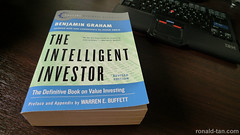Lenders want time; bankers want capital; the agencies want calm; and investors just want out.
Why 2011 is much worse than 2008 Outside the Box – MarketWatch.
Invest Without Emotions
Lenders want time; bankers want capital; the agencies want calm; and investors just want out.
Why 2011 is much worse than 2008 Outside the Box – MarketWatch.

Image by roberthuffstutter via Flickr
The purpose of any business is, at the end of the day, to make money. It could be through providing a service, selling a product, acting as an intermediary or investing in other companies. All of these activities should lead to free cash-flow being generated. At some point, companies have to decide what to do with the excess cash.
What should Infosys do with Rs. 2,42,14,00,00,000 ($5.38 Billion) in cash?
Infosys could try and grow bigger by acquiring smaller companies. However, IT services is a cashflow business; a bigger company will end up stock-piling more cash. For example OFSS (Oracle Financial Services) has more than $1B in cash.
Alternatively, it could buy or fund IT product companies. However, that would mean that Infosys knows more about running or funding IT product companies than the stock holder. Also, what if stock holders don’t want to invest in product companies at all?
Infosys could also buy back its stock. Companies that pay their employees in stock options typically need to buy back their stock to avoid dilution. Infosys’ cash hoard can buy back nearly 25% of its public float and investors benefit from the capital appreciation (higher stock price) that the move would entail. The capital appreciation would result in a tax event for the investor as well.
However, what would Infosys do with all the stock it now owns? It could use it as currency to acquire other companies (pay in equity rather than cash). Or it could start paying out stock options to its employees, etc.
Infosys could choose a third, more simpler alternative: distribute the cash as dividends. Dividends are perhaps the most straight-forward, investor friendly way to return cash to the stock holder. It allow the investor maximum flexibility in deciding what to do with the cash. And since dividends are actual checks that need to get sent out, it means that the accounting profits are actually real profits. In September, Infosys paid out Rs. 40 per share, that is close to $339 million to its public shareholders.
I personally prefer dividends to other forms of returning cash to the stock holder. Its simple, it doesn’t expect the management to work miracles trying to diversify and its cash in the pocket.
Feels like I’m hearing my echo: “The Indian market is narrow, shallow, illiquid and concentrated”.

Image by Ronald HN Tan via Flickr
One of the fundamental strategies we had discussed before was value investing. While looking for value plays, it is important to understand the stage at which the rest of the market is with regard to the specific stock. While you may recognize value in a stock (value opportunity) and decide to invest in it, it might take a while for the market to recognize value and bid up its stock price (value in action). Sometimes, you may just be too early and get trapped in a long position while the rest of the market continues to hammer the stock price down, a la, value trap.
For example, let us take a look at Infosys. Given its strong cash position, professional management and brand, a typical value investor could be easily drawn to the stock. However, investing at any point since the beginning of this year would’ve trapped the investor in a dog stock, with every single pop turning out to be an opportunity for the market to sell.
To take another example, this time of Cisco.
There is no doubt that there is a good value opportunity. It has a ton of overseas profits, it is paying out dividends and buying back its stock, it is a market leader in most of its product categories and has an M&A track-record like you hear about. However, the market has yet to recognize it and just like Infosys, buying the stock at any point since the beginning of the year would’ve been a trap.
As the John Maynard Keynes once said, the markets can be irrational longer than you can remain solvent. Value investors will do good to heed that advise.

Image via Wikipedia
We had a look at candle-sticks, the most popular technical here. Lets turn our attention to fundamental investing. To recap, fundamental investing is based on metrics that are intrinsic to a company. Investors can choose from a broad range of fundamental investing styles to fit their temperament:
Value investing was pioneered by Ben Graham and David Dodd right about the time of the Great Depression. Value investors, typically, buy stocks that trade at a discount to book value, pay out high dividends or have low PE ratios. It involves buying stocks with a “margin of safety”: the discount at which a stock trades to its intrinsic value.
Some characteristics of companies with good value:
In terms of performance, value investing is a lifestyle choice. There are periods where value investing underperforms the broader index. Also, just because something is “value” doesn’t mean that its market price cannot drop further (called the “value trap”).
For example, technology services companies such as HCL and Infosys are typical value plays.
Growth investors look for companies with strong growth potential. Growth stocks may appear over-valued while looking at standard PE or PB multiples, but the expectation of future earnings drive current prices higher.
Some questions that need to be answered while looking at growth stocks are:
Chasing growth can be a volatile experience. A lot of future expectations are factored into the current price levels and any deviation from meeting those expectations can lead to sudden collapse in prices.
For example, stocks like IRB, GMR Infra trade at high PEs because the market expects a lot of growth in the near future.
Buy and Hold investing, as the name suggests, is investing over a long term, typically in excess of 5 years. It goes hand-in-hand with constant-dollar-investing on an index through ETFs or low-cost mutual funds – investors invest a fixed amount of money on a broad, low-cost basket of securities. The idea is that as long as the fundamentals of the economy is strong (over a long term), investors keep buying an index (more when the index falls and less when it rises).
Combined with dividend reinvestment, buy & hold investing is practical for passive investors and has yielded better results compared to active investing when taking into account transaction costs and management fees.